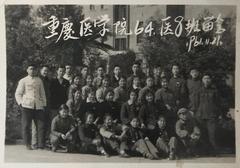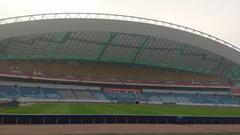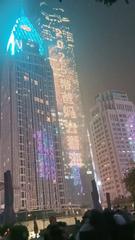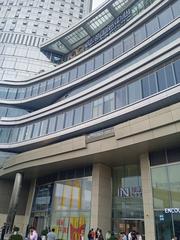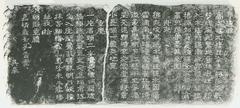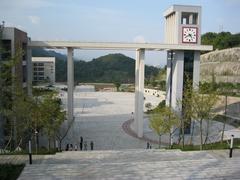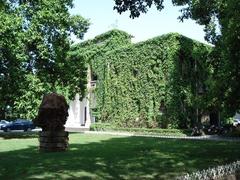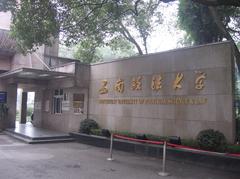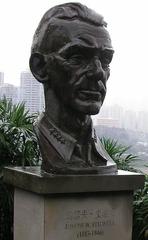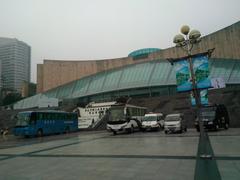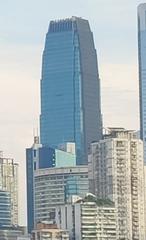Chongqing Poly Tower Visiting Hours Tickets and Travel Guide
Date: 04/07/2025
Introduction to Chongqing Poly Tower and What Visitors Need to Know
Nestled in the dynamic heart of Chongqing, China, the Chongqing Poly Tower stands as a striking emblem of the city’s rapid urban transformation and burgeoning global stature. Known also as the HNA & Poly International Centre, this architectural marvel is located strategically within Chongqing’s bustling central business districts—including Yuzhong and Jiangbei—which are renowned for their blend of historical heritage and cutting-edge modernity. Rising to impressive heights with its twisting glass and steel façade, the tower not only reshapes the city skyline but also embodies Chongqing’s ambition to fuse innovation, sustainability, and cultural identity in one iconic structure.
This comprehensive guide offers an in-depth exploration of Chongqing Poly Tower’s historical significance, architectural innovation, and visitor experience. From its origins on a historically rich site formerly occupied by the Chongqing Hotel, to its role as a catalyst for economic growth and cultural vitality, the tower reflects the city’s evolution from a traditional river port to a global metropolis. Visitors and architecture enthusiasts alike will find detailed information on visiting hours, ticketing options, accessibility features, and the best vantage points for photography. The tower’s design, led by the internationally acclaimed firm Aedas, draws inspiration from natural phenomena like the northern lights, creating a “Dance of Light” effect that makes it a luminous presence day and night.
Beyond its architectural allure, Chongqing Poly Tower serves as a hub for business, hospitality, and cultural events, integrating retail spaces, luxury hotels, and office environments. Its location near prominent Chongqing landmarks such as Raffles City, Luohan Temple, and the Three Gorges Museum enhances its appeal as a focal point for urban exploration. Whether you are planning to soak in panoramic city views, attend cultural exhibitions, or simply appreciate the seamless blend of tradition and modernity, this guide equips you with essential insights and practical tips.
For the most current and detailed information, including ticket purchases and guided tour schedules, visitors are encouraged to consult the official Chongqing tourism website and architectural news sources such as Global Design News and e-architect. Prepare to embark on an unforgettable journey into one of China’s most captivating urban landmarks.
Contents Overview
- Introduction
- Historical Background and Site Transformation
- Origins and Site History
- Architectural Context and Urban Development
- Historical Significance
- Architectural Vision and Design Philosophy
- Structural Innovation and Engineering
- Façade and Materiality
- Urban Context and Integration
- Interior Spatial Experience
- Visitor Information
- Visiting Hours
- Tickets and Admission
- Accessibility
- Special Events and Photography
- Nearby Attractions and Travel Tips
- Cultural and Symbolic Value
- Cultural and Economic Impact
- Urban Icon and Symbol of Modern Chongqing
- Economic Catalyst: Business, Commerce, and Tourism
- Cultural Integration and Urban Identity
- Nighttime Economy and Social Life
- Urban Regeneration and Sustainable Development
- Cultural Tourism and International Recognition
- Impact on Local Communities
- Frequently Asked Questions (FAQ)
- Conclusion and Call to Action
Introduction
Chongqing Poly Tower is a striking modern skyscraper located in the heart of Chongqing’s bustling Jiefangbei central business district (CBD). This article provides not only a historical and architectural overview of the tower but also practical visitor information including visiting hours, ticket details, accessibility, and nearby attractions. Whether you are a history enthusiast, architecture lover, or tourist planning your trip, this guide will help you explore the significance and experience of Chongqing Poly Tower.
Historical Background and Site Transformation
Origins and Site History
Chongqing Poly Tower stands on a historically significant site at the intersection of Linjiangmen and Minsheng Road. This location was once home to the former Chongqing Hotel, a landmark that served travelers and businesspeople during earlier phases of the city’s modernization. The replacement of the hotel with the Poly Tower reflects Chongqing’s broader urban renewal strategy and its transformation from a traditional river port city into a global metropolis.
Architectural Context and Urban Development
As one of nearly 60 skyscrapers in Chongqing exceeding 200 meters, Poly Tower exemplifies the city’s vertical expansion driven by its mountainous terrain and limited flat land. Its glass and steel facade aligns with contemporary Chinese skyscraper design trends, focusing on energy efficiency and integration with commercial spaces. Situated within a dense cluster of high-rises in the Yuzhong District, the tower enhances the city skyline and serves as a focal point for business and tourism.
Historical Significance
The Poly Tower’s construction in the early 21st century coincides with a period of rapid urbanization fueled by China’s economic boom and government initiatives to develop inland cities. Located in the politically and culturally important Yuzhong District, the tower symbolizes Chongqing’s embrace of modernization while representing the loss of some historic architectural heritage.
Visitor Information
Visiting Hours
Chongqing Poly Tower is open to visitors daily from 9:00 AM to 9:00 PM. The best times to visit are during the late afternoon and early evening when the city lights illuminate the skyline, providing stunning photographic opportunities.
Tickets and Admission
Tickets can be purchased online via the official Chongqing tourism website or at the tower’s ticket counters. Prices typically range from 50 to 100 RMB, with discounts available for students, seniors, and children. Guided tours are offered at scheduled times and provide deeper insight into the tower’s architecture and urban significance.
Accessibility
The tower is fully accessible to visitors with disabilities, featuring ramps, elevators, and accessible restrooms to ensure a comfortable visit for all guests.
Special Events and Photography
Chongqing Poly Tower hosts occasional cultural and business events, details of which are announced on its official website. Photographers will find several designated spots within the tower and its surrounding plaza offering panoramic views of Jiefangbei CBD and the confluence of the Jialing and Yangtze Rivers.
Nearby Attractions and Travel Tips
Within walking distance of the Poly Tower are several historical and cultural sites, including the Luohan Temple from the Song Dynasty and the Chongqing Art Museum, which showcases local artistic heritage. The iconic Raffles City Chongqing complex, featuring the Crystal sky bridge, is also easily accessible. The area benefits from well-developed public transportation and pedestrian-friendly infrastructure.
Cultural and Symbolic Value
The Poly Tower stands as a modern counterpart to Chongqing’s rich architectural legacy, including its historic watchtowers and defensive structures unique to the region. Its vertical prominence echoes the traditional importance of towers in the city’s urban landscape, symbolizing resilience and progress.
Conclusion
Chongqing Poly Tower is more than a skyscraper; it is a symbol of Chongqing’s dynamic evolution from a historic river port to a thriving global metropolis. Visitors can appreciate its architectural beauty, historical context, and vibrant urban setting while enjoying convenient access and rich nearby cultural experiences.
Frequently Asked Questions (FAQ)
Q: What are the visiting hours of Chongqing Poly Tower? A: The tower is open daily from 9:00 AM to 9:00 PM.
Q: How can I buy tickets for Chongqing Poly Tower? A: Tickets can be purchased online via the official website or at the ticket counters on-site.
Q: Is Chongqing Poly Tower accessible for wheelchair users? A: Yes, the tower is fully accessible with ramps, elevators, and accessible facilities.
Q: Are there guided tours available? A: Yes, guided tours are available at scheduled times and provide detailed information about the tower.
Q: What are some nearby historical sites to visit? A: Nearby attractions include the Luohan Temple, Chongqing Art Museum, and Raffles City Chongqing.
Call to Action
Plan your visit to Chongqing Poly Tower today to experience a landmark that bridges the city’s rich history and modern ambition. For the latest updates, guided tour schedules, and ticket purchases, download the Audiala app and follow us on social media. Explore more about Chongqing’s historical sites and urban treasures on our website!
Introduction
The Chongqing Poly Tower, also known as the HNA & Poly International Centre, is a must-visit landmark for architecture enthusiasts and travelers exploring Chongqing. Combining cutting-edge design with sustainable features, the tower not only shapes the city’s skyline but also offers visitors a dynamic urban experience. This guide covers everything you need to know about Chongqing Poly Tower visiting hours, ticket information, and its architectural significance, as well as practical tips for your visit.
Architectural Vision and Design Philosophy
The Chongqing Poly Tower stands as a testament to the city’s rapid urban transformation and its embrace of innovative architectural forms. Conceived by the internationally renowned architecture firm Aedas, the tower’s design is rooted in the concept of dynamic movement and light, earning it the nickname “Dance of Light.” The design draws inspiration from the mesmerizing phenomenon of the northern lights, with the building’s twisting form intended to emulate the fluidity and energy of this natural spectacle (Global Design News).
Ken Wai, Global Design Principal at Aedas, describes the tower as an “open public space” and a “city icon,” emphasizing its role not only as a commercial hub but also as a landmark that contributes to Chongqing’s urban identity. The architectural vision was to create a structure that offers ever-changing perspectives of the city, both from within and from the surrounding urban landscape.
Structural Innovation and Engineering
The Chongqing Poly Tower rises to a height of 180 meters (approximately 590 feet) and comprises 39 stories above ground. Its most striking feature is the dramatic twist of its façade, achieved through advanced engineering and the use of double-curved surfaces. This twisting geometry is not merely aesthetic; it also serves to optimize the building’s structural performance and wind resistance, a crucial consideration given Chongqing’s mountainous terrain and variable weather conditions (e-architect).
The tower’s structural system is designed to accommodate the complex loads generated by the twisting form. The core and perimeter columns are carefully aligned to support the curvaceous façade, while the curtain wall system is engineered to follow the building’s undulating contours. This approach required close collaboration between architects, structural engineers, and façade specialists to ensure both visual impact and structural integrity.
Façade and Materiality
The façade of the Chongqing Poly Tower is a defining element of its architectural significance. Composed of high-performance glass and metal panels, the façade is designed to capture and reflect light in a way that changes throughout the day and night. The double-curved surfaces create a sense of movement, making the tower appear to shimmer and dance as the sun moves across the sky or as city lights illuminate it after dark (Global Design News).
This “glowing dance of light” effect is further enhanced by integrated LED lighting, which accentuates the tower’s curves and highlights its sculptural qualities. The use of advanced glazing technology ensures energy efficiency, reducing solar gain while maximizing natural daylight within the interior spaces.
Urban Context and Integration
Located in Xingfu Plaza in the Jiangbei District, the Chongqing Poly Tower occupies a prominent position within one of Chongqing’s most dynamic business and commercial zones. The tower’s design responds to its urban context by providing open public spaces at its base, encouraging pedestrian activity and fostering a sense of community. The ground-level plaza is landscaped and features seating areas, water features, and art installations, making it a welcoming destination for both office workers and visitors (e-architect).
The tower’s orientation and massing are carefully calibrated to maximize views of the surrounding cityscape and the nearby Jialing River. The twisting form allows for a variety of vantage points, offering occupants and visitors unique perspectives of Chongqing’s mountainous skyline and vibrant urban life.
Interior Spatial Experience
Inside, the Chongqing Poly Tower provides flexible, high-quality office spaces catering to modern business needs. The twisting geometry creates floor plates that vary in shape and size, allowing for diverse office configurations. Floor-to-ceiling windows ensure abundant natural light and panoramic views, enhancing the working environment and promoting well-being.
Public areas, including the lobby and communal spaces, are finished with premium materials and feature contemporary art and design elements echoing the tower’s exterior aesthetic. Smart building technologies support efficient management and offer a seamless experience for tenants and visitors.
Visitor Information: Hours, Tickets, and Accessibility
-
Visiting Hours: The Chongqing Poly Tower public areas and plaza are accessible daily from 8:00 AM to 10:00 PM. Guided tours and exhibitions, when available, typically operate from 9:00 AM to 6:00 PM. Visitors are encouraged to check the official website or contact the management office for the most current visiting hours.
-
Tickets: Access to the building’s public plaza and lobby is free. Tickets for guided architectural tours or special exhibitions are available through the official Chongqing Poly Tower website or authorized ticket vendors. Prices vary depending on the event; typical guided tour tickets range from 50 to 100 RMB.
-
Accessibility: The tower is wheelchair accessible, with ramps and elevators facilitating movement throughout public areas. Assistance services can be arranged in advance by contacting visitor services.
-
Travel Tips: The tower is best reached via Chongqing Metro Line 6, alighting at Xingfu Station, then a short walk to Xingfu Plaza. Nearby bus routes and taxi services are also available. Visitors should consider weekday mornings for a quieter experience.
Nearby Attractions and Events
While visiting the Chongqing Poly Tower, travelers can explore nearby Chongqing historical sites such as Ciqikou Ancient Town and the Three Gorges Museum, both within a 15-minute drive. The Jiangbei District offers a variety of dining and shopping options ideal for visitors.
The tower also occasionally hosts special events, including art exhibitions and cultural performances. Visitors should check the official website or local event calendars for upcoming happenings.
Recognition and Awards
The architectural significance of the Chongqing Poly Tower has been recognized internationally. In 2023, it received the prestigious International Architecture Award from The Chicago Athenaeum: Museum of Architecture and Design and The European Centre for Architecture Art Design and Urban Studies (Global Design News). This accolade highlights its innovative design, technical excellence, and contribution to global high-rise architecture.
Sustainability and Environmental Considerations
Sustainability is central to the tower’s architectural approach. It incorporates energy-efficient systems such as high-performance glazing, LED lighting, and intelligent HVAC controls. The façade minimizes heat gain while maximizing daylight, reducing artificial lighting and air conditioning needs.
Water-saving fixtures and green landscaping at the podium enhance environmental performance. The project supports Chongqing’s sustainable urban development goals and serves as a model for future high-rise projects (e-architect).
Iconic Status and Influence
The Chongqing Poly Tower’s bold architectural language and innovative engineering have established it as a new icon on Chongqing’s skyline. Its twisting form distinguishes it from other skyscrapers, such as Raffles City Chongqing and Guanyinqiao Sincere Centre, reinforcing Chongqing’s reputation for cutting-edge architectural experimentation (e-architect).
Its influence inspires architects and developers to pursue expressive forms and sustainable strategies in high-rise construction. As a symbol of Chongqing’s ambition and creativity, the Poly Tower shapes the city’s architectural identity for the 21st century.
Visitor Experience and Architectural Appreciation
Visitors to the Chongqing Poly Tower can immerse themselves in contemporary architecture at its most dynamic. The public spaces, striking façade, and urban integration make it a must-see for architecture enthusiasts and casual tourists alike. Whether viewed from Jiangbei District streets or across the Jialing River, the twisting silhouette and luminous presence leave a lasting impression.
Guided tours and exhibitions offer deeper insights into the design and construction, highlighting the technical and artistic achievements defining the tower (Global Design News).
Frequently Asked Questions (FAQ)
Q: What are the Chongqing Poly Tower’s visiting hours? A: Public areas are open daily from 8:00 AM to 10:00 PM; guided tours generally run from 9:00 AM to 6:00 PM.
Q: Is there an admission fee to visit the tower? A: Access to the plaza and lobby is free. Tickets are required for guided tours and special exhibitions.
Q: How do I buy tickets? A: Tickets can be purchased online via the official website or at authorized vendors.
Q: Is the tower accessible for people with disabilities? A: Yes, the tower has ramps, elevators, and offers assistance services.
Q: What is the best way to get to the Chongqing Poly Tower? A: Take Chongqing Metro Line 6 to Xingfu Station, then walk to Xingfu Plaza. Buses and taxis are also options.
Q: Are there other attractions nearby? A: Yes, nearby attractions include Ciqikou Ancient Town and the Three Gorges Museum.
Visuals and Media
Visitors can view high-quality images and virtual tours of the Chongqing Poly Tower on the official website, featuring alt tags such as “Chongqing Poly Tower twisting façade” and “Dance of Light architectural design Chongqing.” Maps highlighting its location in Jiangbei District are also available online.
Conclusion and Call to Action
The Chongqing Poly Tower represents the perfect blend of visionary architecture, sustainability, and visitor-friendly design. Whether you’re interested in architectural innovation, looking for a scenic urban spot, or exploring Chongqing’s cultural sites, the tower offers an unforgettable experience.
Plan your visit today! Check the official website for the latest information on visiting hours, tickets, and special events. Don’t forget to download the Audiala app for personalized travel tips and updates on Chongqing’s top attractions. Explore related posts on our site about Chongqing’s historical sites and modern landmarks, and follow us on social media to stay inspired and informed.
Introduction
Chongqing Poly Tower, also known as the HNA & Poly International Centre (海航保利国际中心), is a must-visit landmark in the heart of Chongqing’s vibrant Jiefangbei Central Business District. This comprehensive guide will walk you through everything you need to know about visiting Chongqing Poly Tower, including visiting hours, ticket information, architectural highlights, facilities, and practical tips to make the most of your visit.
Location and Accessibility
Chongqing Poly Tower is strategically located at 235 Minsheng Road, Yuzhong District, placing it within easy reach of major commercial, retail, and entertainment hubs. The tower is accessible via Chongqing’s extensive metro system, with Linjiangmen and Jiaochangkou stations nearby. Visitors can also take a short taxi ride from Chongqing’s main railway stations and airport, making it convenient for both tourists and business travelers.
Visiting Hours, Tickets & Entry Information
Visiting Hours
Public access to Chongqing Poly Tower is primarily through its hotel, retail podium, and office areas. While the tower does not have a dedicated public observation deck, visitors can enjoy panoramic views by booking hotel rooms or visiting upper-floor restaurants and lounges. Typical visiting hours for the retail and dining areas are from 10:00 AM to 10:00 PM daily. The hotel reception operates 24/7 for guests.
Tickets and Entry Fees
Entry to the retail podium and public dining spaces is free of charge. For visitors interested in panoramic city views, booking a hotel room or reserving a table at an upper-floor restaurant is required. Ticket prices for hotel stays vary by room type and season. There are no separate tickets for observation; however, special events or guided tours (if available) may require advance booking and fees.
How to Purchase Tickets
Hotel room reservations and restaurant bookings can be made online via the official hotel website or popular travel platforms. For special events or conferences, tickets and access arrangements are typically handled through event organizers or the tower’s management office. It is recommended to check availability and book in advance, especially during peak tourist seasons.
Visitor Restrictions and Policies
Visitors entering office areas may require prior authorization or appointments. Standard security protocols are in place, including ID checks and bag screening. The tower is wheelchair accessible, featuring ramps, elevators, and accessible restrooms.
Architectural Features and Significance
Standing at 286.8 meters (941 feet) with 61 floors above ground and 6 below, Chongqing Poly Tower is the city’s third tallest building. Its all-concrete structure is engineered to withstand seismic activity and adapts to Chongqing’s unique mountainous terrain. The tower’s sleek minimalist façade complements the city’s modern skyline while respecting its urban context. It symbolizes Chongqing’s rapid urbanization and ambition to become a world-class metropolis.
Mixed-Use Spaces: Offices, Hotel, and Retail
The tower incorporates office spaces for multinational corporations and local enterprises, a luxury hotel with 469 rooms, and a retail podium featuring boutiques, cafes, and restaurants. The hotel offers upscale amenities, including a fitness center, spa, indoor pool, and executive lounges. Dining options range from international buffets to specialty Chinese cuisine, often with stunning city views.
The Poly Tower Experience: What to Expect
Arrival and First Impressions
Visitors are welcomed by a grand lobby with high ceilings, polished stone finishes, and contemporary art. Multilingual concierge and security staff facilitate smooth entry.
Elevators and Vertical Transportation
The building has 37 high-speed elevators, some reaching speeds up to 6 meters per second, minimizing wait times and ensuring efficient access to all floors.
Views and Photo Opportunities
Although there is no dedicated public observation deck, guests staying at the hotel or dining in upper-floor restaurants can enjoy breathtaking views of Chongqing’s skyline, the Yangtze and Jialing Rivers, and the surrounding mountains. For the best photo opportunities, request a river-facing room or high-floor seating.
Events, Conferences, and Guided Tours
The tower hosts various business meetings, seminars, and private functions in customizable spaces equipped with advanced audiovisual systems. Occasionally, guided tours or special events may be organized; visitors should check official announcements or inquire at the concierge desk for current offerings.
Practical Visitor Tips
- Best Time to Visit: Evening visits offer spectacular views of Chongqing’s illuminated skyline.
- Dress Code: Smart-casual is suitable for public areas; business attire is recommended for office visits.
- Language: English is commonly spoken by hotel and concierge staff; however, signage is primarily in Chinese.
- Accessibility: Fully wheelchair accessible with ramps, elevators, and facilities.
- Security: Standard checks at entrances; carry valid ID.
- Parking: 700 parking spaces available, though public transport is advised due to city traffic.
- Nearby Attractions: Steps from the People’s Liberation Monument, Hongya Cave, and prominent shopping and nightlife venues.
How to Get There
- By Metro: Linjiangmen and Jiaochangkou stations on Chongqing Metro are the closest stops.
- By Taxi: Easily accessible from Chongqing North and West Railway Stations and Jiangbei International Airport.
- By Bus: Multiple bus routes serve the Jiefangbei area.
Cultural and Urban Context
Chongqing Poly Tower exemplifies the city’s fusion of history and modernity, standing tall amidst ancient temples and futuristic skyscrapers. Its presence in Jiefangbei highlights the district’s role as Chongqing’s economic and cultural heartbeat.
Frequently Asked Questions (FAQs)
Q: Are there public visiting hours for Chongqing Poly Tower’s observation areas? A: The tower does not have a dedicated public observation deck. Visitors can enjoy views by booking hotel rooms or dining at upper-floor venues.
Q: Are tickets required to enter the tower? A: Entry to retail and dining areas is free. Hotel stays and some events may require advance booking.
Q: Is Chongqing Poly Tower wheelchair accessible? A: Yes, the building includes ramps, elevators, and accessible restrooms.
Q: Can I buy tickets online? A: Hotel and restaurant bookings can be made online. Event tickets depend on organizers.
Q: What are the best times to visit? A: Evening visits provide stunning illuminated city views.
Conclusion
Chongqing Poly Tower offers a unique blend of modern architecture, luxury amenities, and cultural significance right in the heart of one of China’s most dynamic cities. Whether you’re a business traveler, a tourist seeking panoramic views, or an architecture enthusiast, planning your visit around the tower’s hours, ticket options, and facilities ensures a memorable experience. Don’t forget to explore nearby historical sites and vibrant neighborhoods that enrich your Chongqing adventure.
For more travel tips and updates on Chongqing’s attractions, be sure to check our related articles and follow us on social media. Download the Audiala app for personalized travel guides and seamless trip planning.
Note: For the best experience, include high-quality images of Chongqing Poly Tower with alt tags such as “Chongqing Poly Tower visiting hours,” “Chongqing Poly Tower tickets,” and “Chongqing historical sites.” Embedding maps and links to virtual tours when available is also recommended.
Chongqing Poly Tower: Visiting Hours, Tickets, and Its Cultural & Economic Impact
Introduction
Chongqing Poly Tower is not only a modern architectural marvel but also a vibrant cultural and economic hub in the heart of Chongqing. Whether you’re planning your visit or interested in the tower’s role in shaping the city’s urban identity, this comprehensive guide covers everything from visiting hours and ticket information to the tower’s significant cultural and economic impact. Discover why Chongqing Poly Tower is a must-see landmark among Chongqing historical sites.
Visiting Chongqing Poly Tower: Hours, Tickets, and Tips
Visiting Hours
The tower welcomes visitors daily from 9:00 AM to 9:00 PM, with the last entry allowed at 8:30 PM. These hours provide ample opportunity for visitors to enjoy panoramic daytime views as well as the dazzling illuminated nighttime skyline.
Ticket Information
Tickets for the observation decks and other attractions inside Chongqing Poly Tower can be purchased online or at the venue. Prices vary by package, with standard tickets starting at RMB 80 for adults. Discounts are often available for children, seniors, and group bookings. To avoid queues, it is recommended to buy Chongqing Poly Tower tickets online in advance.
Accessibility and Travel Tips
The tower is easily accessible via public transportation, including the Chongqing Metro, with clear signage directing visitors. Elevators and ramps ensure accessibility for visitors with disabilities. For the best photographic spots, visit the observation decks during sunset or at night to capture the city’s glowing skyline.
Guided Tours
Various guided tours are offered, including cultural and architectural highlights of the tower and surrounding historical sites. These tours provide deeper insight into Chongqing’s urban transformation and the tower’s place within it.
Cultural and Economic Impact
Urban Icon and Symbol of Modern Chongqing
Chongqing Poly Tower stands as a striking testament to Chongqing’s rapid urban transformation and emergence as a major economic and cultural powerhouse in southwest China. As one of the city’s tallest skyscrapers, it prominently shapes the Chongqing skyline, reinforcing the city’s reputation as an “8D Magic City” where futuristic architecture rises from mountainous terrain (sameerabuildingconstruction.com). The tower’s illuminated façade, especially at night, contributes to the celebrated nightscape, attracting locals and tourists alike (livingnomads.com).
Economic Catalyst: Business, Commerce, and Tourism
Business and Commercial Hub
As a mixed-use development housing Grade-A office spaces, luxury hotels, and high-end retail outlets, Chongqing Poly Tower anchors the city’s central business district (CBD). It attracts multinational corporations, financial institutions, and startups, thereby boosting Chongqing’s GDP and employment rates. The service sector, driven by finance and real estate, accounts for over 50% of Chongqing’s output (sameerabuildingconstruction.com).
Tourism and Hospitality
The tower’s observation decks and luxury hotels draw business travelers and tourists seeking panoramic views of the Yangtze and Jialing Rivers confluence. Nearby attractions like Raffles City Chongqing and Hongya Cave encourage longer visits and increased spending (chinaxiantour.com). In 2024, Chongqing hosted over 300 million visitors, with landmarks such as Poly Tower playing a pivotal role.
Cultural Integration and Urban Identity
Architectural Innovation and Local Pride
Incorporating elements inspired by Chongqing’s mountainous geography and riverine landscape, the tower blends modern aesthetics with local identity (medium.com). Featured prominently in city branding, it fosters pride among residents and symbolizes Chongqing’s global ascent.
Venue for Cultural Events and Exhibitions
Public spaces within the tower regularly host art exhibitions, cultural performances, and business forums. Special events during Lunar New Year and National Day feature themed light shows, attracting large crowds (livingnomads.com).
Nighttime Economy and Social Life
Illuminated Skyline and Night Tourism
The tower’s LED lighting is synchronized with nearby skyscrapers to create dynamic light shows narrating Chongqing’s history (sameerabuildingconstruction.com). These nightly spectacles boost revenue for nearby entertainment venues and contribute to Chongqing’s status as a top destination for night tours and river cruises.
Social Gathering and Lifestyle
High-rise restaurants, sky bars, and lounges within the tower offer spectacular views and vibrant social spaces favored by young professionals and tourists alike.
Urban Regeneration and Sustainable Development
Revitalization of the Central Business District
The tower has catalyzed infrastructure improvements, green space development, and smart city initiatives in the CBD (sameerabuildingconstruction.com).
Environmental Considerations
Designed with energy efficiency in mind, features such as double-glazed windows and rainwater harvesting reduce the tower’s carbon footprint. Chongqing’s renewable energy reliance, especially hydropower, enhances its sustainability.
Cultural Tourism and International Recognition
Showcasing Chongqing’s Modernity
Featured in international travel guides, the tower offers unparalleled views of Chongqing’s unique topography, positioning the city as a blend of tradition and innovation (chinaxiantour.com).
Attracting Global Events
With world-class facilities, Chongqing Poly Tower hosts international conferences and exhibitions, enhancing the city’s global profile.
Impact on Local Communities
Employment and Skills Development
Operations generate thousands of jobs and provide training in green building and smart city management.
Community Engagement
Public art, charity events, and educational programs help bridge modernization with cultural heritage preservation.
Frequently Asked Questions (FAQ)
Q: What are Chongqing Poly Tower’s visiting hours? A: Open daily from 9:00 AM to 9:00 PM, with last entry at 8:30 PM.
Q: How can I buy Chongqing Poly Tower tickets? A: Tickets can be purchased online or at the venue. Online booking is recommended to avoid queues.
Q: Are there guided tours available? A: Yes, various guided tours covering cultural and architectural highlights are offered.
Q: Is the tower accessible for people with disabilities? A: Yes, the tower features elevators and ramps to ensure accessibility.
Q: What are some nearby Chongqing historical sites? A: Notable nearby sites include Hongya Cave and Raffles City Chongqing.
Conclusion and Call to Action
Chongqing Poly Tower is a cornerstone of Chongqing’s urban identity, blending cultural richness with economic vitality. Whether visiting for the breathtaking views, cultural events, or business opportunities, it offers an unforgettable experience. Plan your visit today by securing your tickets online, and stay updated on events and travel tips by following our social media channels. Don’t forget to explore related articles on other Chongqing historical sites and download the Audiala app for the latest city guides and updates.
Images and interactive maps of Chongqing Poly Tower and surrounding attractions are available on our website to enhance your visit planning.
Summary of Key Information About Visiting Chongqing Poly Tower
The Chongqing Poly Tower stands as a multifaceted symbol of Chongqing’s remarkable urban evolution, intertwining architectural brilliance, cultural resonance, and economic vitality. As one of the tallest and most innovative skyscrapers in the city, its twisting design and energy-efficient features showcase how modern engineering can harmonize with environmental and aesthetic considerations. Beyond its physical presence, the tower functions as a vibrant cultural and commercial nucleus—housing luxury hotels, offices, retail spaces, and hosting dynamic events that enrich the city’s social fabric.
Visitors to Chongqing Poly Tower can expect more than just panoramic vistas; they can immerse themselves in the narrative of a city that honors its historical roots while embracing future aspirations. The tower’s accessibility and well-curated visitor services ensure a welcoming experience for diverse audiences, including families, business travelers, and architecture enthusiasts. Its proximity to celebrated Chongqing historical sites and entertainment districts further amplifies its appeal as a must-visit destination.
Economically, the tower drives growth by attracting multinational corporations, boosting tourism, and supporting the local service sector, thereby playing a pivotal role in Chongqing’s emergence as a southwestern China powerhouse. Culturally, it anchors community engagement through art exhibitions, festivals, and public events that celebrate the city’s unique identity and global outlook.
To fully appreciate all that Chongqing Poly Tower has to offer—whether its architectural marvels, cultural events, or scenic viewpoints—potential visitors should plan ahead by securing tickets online, checking official schedules, and utilizing resources like the Audiala travel app for personalized guides and updates. For more information, official sources such as sameerabuildingconstruction.com and livingnomads.com provide valuable insights.
Experience the vibrant pulse of Chongqing through the lens of the Poly Tower—where history, innovation, and culture converge to offer an unforgettable urban journey.
Sources and Further Reading
- Ken Wai and Aedas complete the world’s most twisted tower in Chongqing as a glowing Dance of Light with a curvaceous facade that offers ever-changing city perspectives, 2023, Global Design News https://globaldesignnews.com/ken-wai-and-aedas-complete-the-worlds-most-twisted-tower-in-chongqing-as-a-glowing-dance-of-light-with-a-curvaceous-facade-that-offers-ever-changing-city-p/
- Chongqing architecture news, 2023, e-architect https://www.e-architect.com/china/chongqing-architecture-news
- Chongqing a city of innovation, sustainability and urban excellence, 2024, Sameera Building Construction https://sameerabuildingconstruction.com/chongqing-a-city-of-innovation-sustainability-and-urban-excellence/
- Must-visit places in Chongqing, 2025, Living Nomads https://livingnomads.com/2025/01/must-visit-places-in-chongqing/
- Chongqing travel guide, Things to do, 2025, China Xian Tour https://www.chinaxiantour.com/chongqing-travel-guide/things-to-do.html
- Chongqing: A city of innovation, sustainability and urban excellence, 2024, Medium https://medium.com/@SAMJADESBUILDINGCONSTRUCTION/chongqing-a-city-of-innovation-sustainability-and-urban-excellence-d3ea5c4903f3

